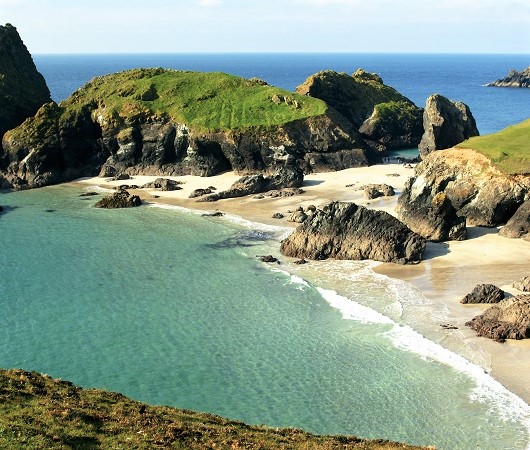Kynance Cove, Cornwall
6th July 2021

A coastal haven that once provided summer repose for the Victorian elite, Kynance Cove has welcomed many distinguished visitors over the years, including Queen Victoria and Prince Albert. Now owned and managed by the National Trust, it is one of the most famous beauty spots in Cornwall and the UK and remains a magnet for beach-zealots, artists and photographers.
Getting to Kynance Cove
Only a stone’s throw from the most southerly point in mainland Britain, the serpentine-flecked shores of Kynance Cove aren’t hard to find. For the adventurers, one of the best ways to arrive at the cove is via the coast path from the Lizard Point. Bypassing the roads and summer traffic, this 2-mile walk affords stunning views the whole way.
Otherwise, you can make your way to the National Trust-run car park. Once you’ve parked your wheels, follow the signposts and walk for 15 minutes or so down towards the cove. The path, somewhat steep, is a little more challenging on the ascent! Please note, there are sometimes slippery stones to clamber over at the bottom of the path depending on sand levels, so good mobility is needed.

Kynance’s Serpentine and Geology
The sight of the cove’s white sands, turquoise waters, dark red and green serpentine stones and sea islands is one that never fails to take your breath away, no matter how many times you have seen it before. That said, few people realise how significant the area’s geology actually is. As it happens, much of the Lizard Peninsula was once about 6 miles below the surface of the earth. Subject to extreme heat and pressure, the molten rock that eventually formed the Lizard finally surfaced in the Rheic Ocean (thousands of miles away) over 300 million years ago.
From then, it took until the start of the last Ice Age for it to travel halfway across the globe and reach its current position. These days, Kynance Cove is an important site for geologists because it is home to two types of rare serpentine rock: bastite and tremolite. In fact, it’s not just geologists who appreciate Serpentine either – Queen Victoria and Prince Albert admired it so much that they ignited a trend for serpentine jewellery and ornaments back in the day! Even now, serpentine is still turned in the village.
.jpg)
Exploring the Beach
The BBC has described Kynance Cove as "one of the most beautiful stretches of coastline in the South West" – and we can see why. A world away from city streets, it inspires wonder in all those who visit and beckons for discovery throughout the year. While little of the beach remains at high tide, at low tide you can easily explore the cove’s islands and stacks. Formed of tremolite serpentine, granite and basalt, these characterful islands are called the Bishop, Gull Rock, Asparagus Island and Steeple Rock from left to right.
Elsewhere in the cove, you can wander around some of the many caves hidden within towering cliffs, like the Parlour and the Drawing Room, or wander up to the green on the opposite side for beautiful views. Later on, at mid-tide, you may even be able to catch a show from the Devil's Bellows if you are lucky – a blowhole on Asparagus Island.
For refreshments, there is a seasonal café in the cove and there is a seasonal dog ban in summer.